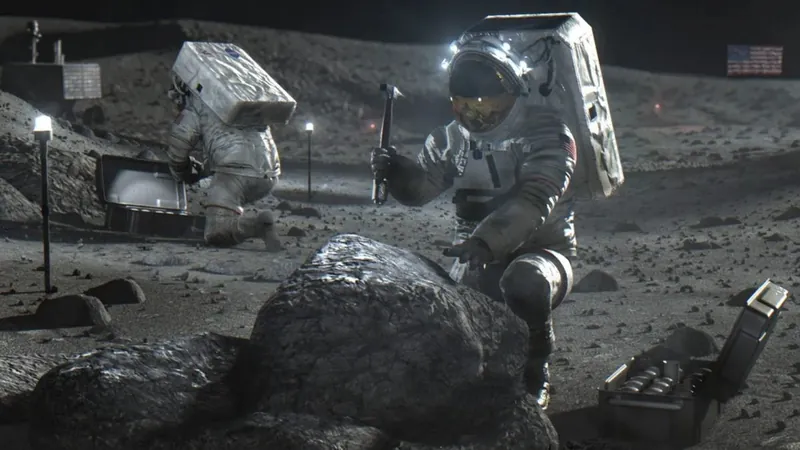
Moon's Secrets Revealed: Engineers Unveil Plans to Harvest Oxygen and Valuable Resources from Lunar Soil!
2025-01-24
Author: Daniel
Moon's Secrets Revealed: Engineers Unveil Plans to Harvest Oxygen and Valuable Resources from Lunar Soil!
A team of groundbreaking engineers is paving the way for sustainable lunar living by developing technology to extract oxygen from the Moon's crust, also known as regolith. This revolutionary endeavor, led by Sierra Space, a private aerospace company, aims to equip future astronauts with the ability to produce oxygen directly on the lunar surface, dramatically reducing the need for costly supplies from Earth.
At the heart of this innovation is a specially designed machine that resembles a compact metal box adorned with colorful wires. This device operates by heating lunar regolith to extreme temperatures, prompting oxygen molecules to bubble up and escape — a technique highlighted in a recent BBC report. This pioneering experiment, carried out at NASA's Johnson Space Center over the summer, demonstrates substantial progress toward lunar oxygen production.
Why Oxygen Extraction is Crucial for Lunar Exploration
As we plan for permanent human bases on the Moon, the necessity for generating oxygen from local resources cannot be overstated. Transporting oxygen from Earth is economically unviable, and the ability to produce it on the Moon could save space agencies and private companies billions of dollars in mission expenses. Lunar regolith is rich in metal oxides, making it a potent source of oxygen, but adapting technology to thrive in the Moon’s notoriously harsh environment poses a unique set of challenges.
Sierra Space utilizes a process known as carbothermal reduction to enable the extraction of oxygen. This technique has the advantage of being more effective under the Moon's low gravity conditions than other methods, such as molten regolith electrolysis, which struggles to form and detach oxygen bubbles efficiently in such an environment.
Conquering the Moon's Low Gravity Challenges
With the Moon's gravity being only one-sixth that of Earth, typical oxygen extraction methods face significant hurdles. For instance, when using molten regolith electrolysis, oxygen bubbles tend to rise more slowly, causing delays in the extraction process. However, engineers like Paul Burke from Johns Hopkins University are exploring innovative solutions such as vibrating the oxygen-producing devices and optimizing the design of electrodes to enhance bubble detachment.
Sierra Space's method circumvents these challenges entirely by allowing oxygen to form freely within the regolith. This groundbreaking approach positions it as a potentially superior option for lunar resource extraction.
Unlocking Lunar Treasures: More Than Just Oxygen
Beyond the vital need for breathable air, the Moon's regolith boasts a wealth of valuable materials. Researchers like Palak Patel from MIT are exploring the extraction of metals such as iron, titanium, and lithium from lunar soil. These essential resources could be transformed into tools, parts, and construction materials crucial for establishing a sustainable lunar habitat.
Patel's research team is even looking at how to convert regolith into durable, glass-like bricks, ideal for building structures on the Moon. The ultimate goal is to minimize reliance on Earth for resupply missions, thus making long-term lunar habitation a reality.
As we stand on the brink of a new era in space exploration, the prospect of utilizing the Moon’s natural resources is integral to supporting future human missions, especially as we set our sights on Mars. The technologies being developed today offer an exciting preview of a future where astronauts could become self-sufficient, thriving off the land — not merely surviving, but living on the Moon itself!
Stay tuned as we continue to follow these revolutionary developments that could soon change humanity's relationship with the Moon!




 Brasil (PT)
Brasil (PT)
 Canada (EN)
Canada (EN)
 Chile (ES)
Chile (ES)
 Česko (CS)
Česko (CS)
 대한민국 (KO)
대한민국 (KO)
 España (ES)
España (ES)
 France (FR)
France (FR)
 Hong Kong (EN)
Hong Kong (EN)
 Italia (IT)
Italia (IT)
 日本 (JA)
日本 (JA)
 Magyarország (HU)
Magyarország (HU)
 Norge (NO)
Norge (NO)
 Polska (PL)
Polska (PL)
 Schweiz (DE)
Schweiz (DE)
 Singapore (EN)
Singapore (EN)
 Sverige (SV)
Sverige (SV)
 Suomi (FI)
Suomi (FI)
 Türkiye (TR)
Türkiye (TR)
 الإمارات العربية المتحدة (AR)
الإمارات العربية المتحدة (AR)